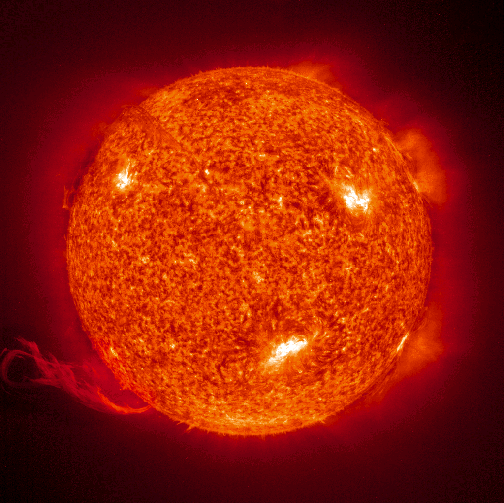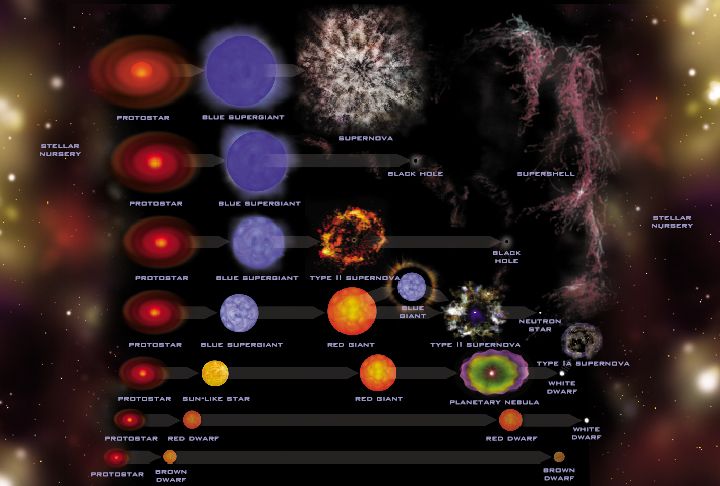Do stars explode in the end?
What happens to all the stars of the universe when they get old? Nothing can exist forever, and the stars also can not. Why? Because they run out of fuel: for example, all hydrogen is converted to helium. When the fuel runs out, something must happen. As the poet Dylan Thomas wrote:
But what specifically happens to a star depends very much on its mass.

')
If you have a tiny star, less than 40% of the mass of the Sun, it burns all the hydrogen, turning it into helium, and it does not have enough mass to burn helium further. The sun can turn helium into carbon and oxygen, and even more massive stars will burn it all down and turn it into iron. Most stars in this category, when they run out of fuel, will first expand into a giant star, and then shrink into a white dwarf.

White dwarfs do not burn anything, and are called white only because they emit light produced by the energy of gravitational contraction. (To estimate the size, recall that the radius of the Earth is 6371 km). When, after several billion years, their compression ends, they cease to emit light and turn into black dwarfs. But the most massive stars with iron cores, having a radius of 8 times the size of the Sun, turn into supernovae. When they are compressed, the pressure on the iron becomes so great that the star begins to synthesize neutrons from protons and electrons in the iron atoms. This leads to the release of enormous energy, known as a supernova explosion.
Even more massive stars make a supernova explosion even more powerful, and then they are called hypernovas. Stars, the mass of which is 10-100 times the solar one, may turn into hypernova.
And maybe they will not turn! Irish astronomers track the explosions of stars with the Hubble telescope. They are trying to find out the masses of stars before they turn into supernovae, by determining which particular star exploded. And they found that some stars can be so massive that they do not turn into supernovae or hypernovae, and after the end of the burning of fuel collapses into a black hole. This is interesting because, in theory, not the most massive stars are involved in this, since their radii are too large for them to collapse into black holes. It is believed that only stars from a certain mass range collapse into a black hole. I found such a diagram illustrating the fate of the stars, depending on their initial mass:

I would be interested to know whether the most massive of the stars of our galaxy, Eta Carina, the Star Pistol (one of the brightest stars in our Galaxy) and LBV 1806-20, will turn into hypernovae or immediately become black holes? It may depend on which side of Eddington’s limit they are on, but perhaps it will also depend on whether they ever read Dylan Thomas!
Do not leave the night forever.
Fight, fight, that day did not fade away
But what specifically happens to a star depends very much on its mass.

')
If you have a tiny star, less than 40% of the mass of the Sun, it burns all the hydrogen, turning it into helium, and it does not have enough mass to burn helium further. The sun can turn helium into carbon and oxygen, and even more massive stars will burn it all down and turn it into iron. Most stars in this category, when they run out of fuel, will first expand into a giant star, and then shrink into a white dwarf.

White dwarfs do not burn anything, and are called white only because they emit light produced by the energy of gravitational contraction. (To estimate the size, recall that the radius of the Earth is 6371 km). When, after several billion years, their compression ends, they cease to emit light and turn into black dwarfs. But the most massive stars with iron cores, having a radius of 8 times the size of the Sun, turn into supernovae. When they are compressed, the pressure on the iron becomes so great that the star begins to synthesize neutrons from protons and electrons in the iron atoms. This leads to the release of enormous energy, known as a supernova explosion.
Even more massive stars make a supernova explosion even more powerful, and then they are called hypernovas. Stars, the mass of which is 10-100 times the solar one, may turn into hypernova.
And maybe they will not turn! Irish astronomers track the explosions of stars with the Hubble telescope. They are trying to find out the masses of stars before they turn into supernovae, by determining which particular star exploded. And they found that some stars can be so massive that they do not turn into supernovae or hypernovae, and after the end of the burning of fuel collapses into a black hole. This is interesting because, in theory, not the most massive stars are involved in this, since their radii are too large for them to collapse into black holes. It is believed that only stars from a certain mass range collapse into a black hole. I found such a diagram illustrating the fate of the stars, depending on their initial mass:

I would be interested to know whether the most massive of the stars of our galaxy, Eta Carina, the Star Pistol (one of the brightest stars in our Galaxy) and LBV 1806-20, will turn into hypernovae or immediately become black holes? It may depend on which side of Eddington’s limit they are on, but perhaps it will also depend on whether they ever read Dylan Thomas!
Source: https://habr.com/ru/post/396343/
All Articles